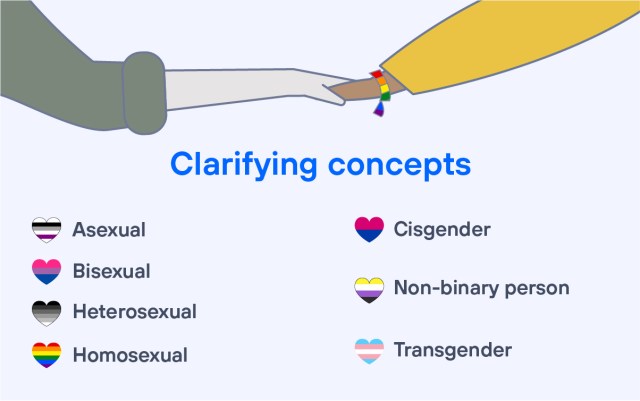Although throughout the text we will break down the concrete and specific meaning of numerous terms related to sexual and gender diversity, we will first briefly explain what is meant by the two terms that give the article its title.
Sexual diversity refers to all the variety of sexes, sexual orientations and gender identities without developing the specificities of each identity, behavior or characteristic; that is, all the different options available to people when it comes to assuming, expressing and living sexuality.
On the other hand, gender identity is understood as the individual experience of each person, which does not necessarily coincide with the gender attributed at birth. Gender identity may not correspond to any gender or to more than one, and should not be confused with sexual orientation.
Terms to better understand gender and sexual diversity
To continue analyzing, explaining and, perhaps, clarifying some concepts related to gender and sexual diversity, we could establish three categories: sexual orientation (according to the emotional, affective and/or sexual attraction felt by other people), gender identity (as we have already said, the internal experience of each person) and sex (which is determined by nature).
Although it is true that we could go into greater detail and develop different typologies within some of the terms analyzed, at least we hope that by specifying the basic characteristics of each one of them, any possible doubts that may exist will be clarified.
Sexual orientation
Sexual orientation refers to the capacity of each person to feel attracted (emotionally, affectively and/or sexually) to other people. Depending on different possibilities there are the following types:
- Asexual. Although it might not be included as a type since it refers to the absence of sexual orientation, it refers to those people who have little or no interest in sexual activity. It should not be confused with celibacy or abstinence, which is a personal choice for different reasons.
- Bisexual. A person who is attracted to people of the same or opposite gender, although it is true that this attraction is not necessarily divided proportionally between the different genders.
- Heterosexual. These are people who are attracted to people of the opposite gender.
- Homosexual. This last category refers to people who are attracted to people of the same gender. In the specific case of women, the term lesbianism is used.
Gender identity
The term gender identity (which we have already explained at the beginning of the article) contains two different categories:
- Cisgender. This refers to people whose gender matches the sex assigned at birth and usually matches societal expectations of how men and women should be.
- Non-binary person: A person assigned as female or male at birth but whose gender identity does not match either of these two categories, identifying as neither male nor female or identifying with both in a fluid way.
- Transgender. There is a wide range of options within this generic term (transsexuals, transvestites, gender queer, agender…) with the common feature that their gender identity does not match conventional expectations about the gender and sex assigned at birth. Some trans people identify as male or female, although others perceive it as a continuum between the two that goes beyond a binary identity. Trans identity has nothing to do with sexual orientation, which can be of any of the types we have seen above. In some cases, people in this category develop gender transitions to match their sexual characteristics with their internal sense of gender identity, and surgery is not essential in these cases.

Sex
In this case, we are talking about a purely anatomical and biological issue based on genitalia and chromosomes.
- Males. People whose sex assigned at birth (biological sex) is male because they have XY chromosomes and male reproductive system.
- Intersex. Those persons whose sexual characteristics do not correspond to the existing standards related to the sexual or reproductive anatomy of women or men. These are people who are born with variations in their genetic, hormonal or anatomical characteristics that are neither totally masculine nor totally feminine.
- Female. Persons whose biological sex is female because they have XX chromosomes and a female reproductive system.
Bringing technology closer to bridge the gap
With the aim of bringing technology closer to the differences, Telefónica develops workshops and courses on LGBT+ diversity as well as internal campaigns to protect the rights of people of this group.
As explained on our corporate website, “we guarantee a safe and trusting space, where all employees feel free to be themselves regardless of their sexual orientation or identity. In this regard, we have specific initiatives to attract and promote the development and well-being of transgender people”.
For Telefónica, “diversity in any of its forms represents growth and talent, since diverse teams enhance professional development and stimulate innovation within the organisation, boosting our performance”.











